初中英语副词作状语的用法
初中的归纳常见的形容词与副词的用法总结
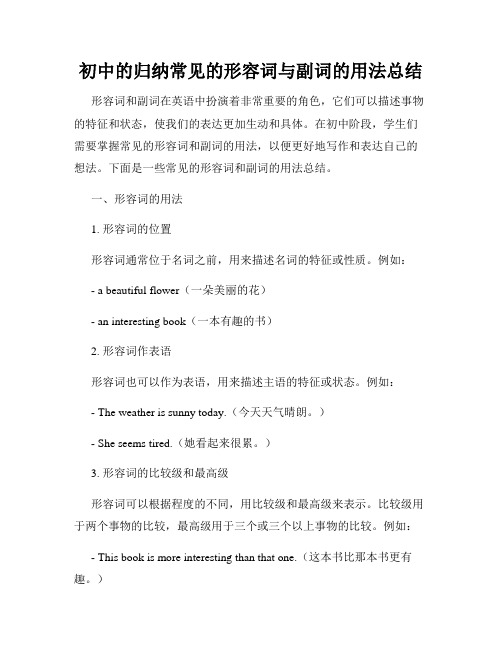
初中的归纳常见的形容词与副词的用法总结形容词和副词在英语中扮演着非常重要的角色,它们可以描述事物的特征和状态,使我们的表达更加生动和具体。
在初中阶段,学生们需要掌握常见的形容词和副词的用法,以便更好地写作和表达自己的想法。
下面是一些常见的形容词和副词的用法总结。
一、形容词的用法1. 形容词的位置形容词通常位于名词之前,用来描述名词的特征或性质。
例如:- a beautiful flower(一朵美丽的花)- an interesting book(一本有趣的书)2. 形容词作表语形容词也可以作为表语,用来描述主语的特征或状态。
例如:- The weather is sunny today.(今天天气晴朗。
)- She seems tired.(她看起来很累。
)3. 形容词的比较级和最高级形容词可以根据程度的不同,用比较级和最高级来表示。
比较级用于两个事物的比较,最高级用于三个或三个以上事物的比较。
例如:- This book is more interesting than that one.(这本书比那本书更有趣。
)- English is the most widely spoken language in the world.(英语是世界上使用最广泛的语言。
)二、副词的用法1. 副词的位置副词通常位于动词之前,用来修饰动作的方式、程度或频率。
例如:- He runs fast.(他跑得快。
)- She speaks English fluently.(她流利地讲英语。
)2. 副词作状语副词可以作为状语,用来描述动词、形容词或其他副词的方式、程度或频率。
例如:- He sings loudly.(他大声唱歌。
)- The car is too expensive.(这辆车太贵了。
)3. 副词的比较级和最高级副词的比较级和最高级的形式和用法与形容词类似。
例如:- She runs faster than her brother.(她跑得比她哥哥快。
英语副词的用法大全

英语副词的用法大全副词在句中可用作:1)状语(这是副词在句子中的主要功用)It is raining hard.雨下得很大。
(副词hard作状语,修饰动词is raining。
) Don't drive too fast.车子不要开得太快。
(fast是副词,作状语,修饰动词drive,副词too又修饰副词fast。
)He speaks English quite well.他英语讲得相当好。
(well修饰动词speaks,quite又修饰副词well。
)This is a fairly useful tool,这是一件相当有用的工具。
(fairly修饰形容词useful)He has always helped his sister with her homework.他一向帮助他妹妹做家庭作业。
(always修饰动词has helped)She often went there.她常到那儿去。
(often和there均是副词,修饰动词went。
)Perhaps he will telephone later.也许他以后会打电话来的。
(perhaps 是副词,用以修饰全句。
)2)表语Is he up?他起床了没有?She is out.她出去了。
3)定语Life here is full of joy.这儿的生活充满了欢乐。
(here修饰名词life) 副词的位置1)修饰动词时,有三种位置。
2)修饰形容词和副词时,须放在被修饰词之前。
如:It is a rather difficult job,这是一件颇为困难的工作。
(rather修饰形容词difficult)He runs very fast.他跑得很快。
(very修饰副词fast)3)副词作定语时,一般放在被修饰的名词之后。
如:The peasants there are busy digging a canal now.那里的农民现在正忙于修水渠。
英语中状语从句用法及例句总结(完整)
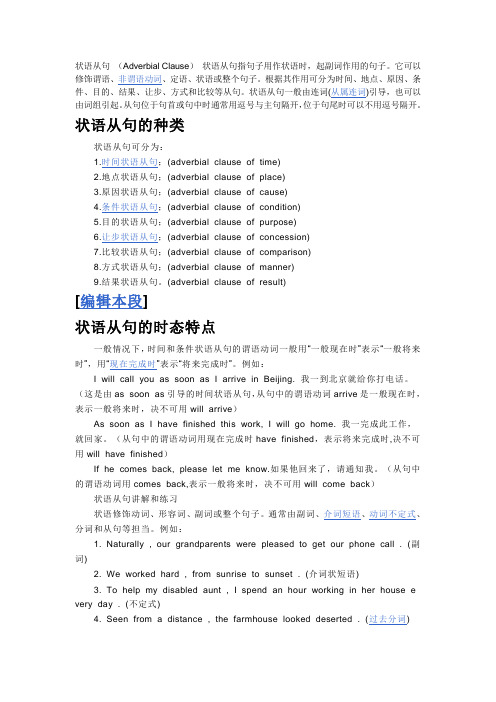
状语从句(Adverbial Clause)状语从句指句子用作状语时,起副词作用的句子。
它可以修饰谓语、非谓语动词、定语、状语或整个句子。
根据其作用可分为时间、地点、原因、条件、目的、结果、让步、方式和比较等从句。
状语从句一般由连词(从属连词)引导,也可以由词组引起。
从句位于句首或句中时通常用逗号与主句隔开,位于句尾时可以不用逗号隔开。
状语从句的种类状语从句可分为:1.时间状语从句;(adverbial clause of time)2.地点状语从句;(adverbial clause of place)3.原因状语从句;(adverbial clause of cause)4.条件状语从句;(adverbial clause of condition)5.目的状语从句;(adverbial clause of purpose)6.让步状语从句;(adverbial clause of concession)7.比较状语从句;(adverbial clause of comparison)8.方式状语从句;(adverbial clause of manner)9.结果状语从句。
(adverbial clause of result)[编辑本段]状语从句的时态特点一般情况下,时间和条件状语从句的谓语动词一般用“一般现在时”表示“一般将来时”,用“现在完成时”表示“将来完成时”。
例如:I will call you as soon as I arrive in Beijing. 我一到北京就给你打电话。
(这是由as soon as引导的时间状语从句,从句中的谓语动词arrive是一般现在时,表示一般将来时,决不可用will arrive)As soon as I have finished this work, I will go home. 我一完成此工作,就回家。
(从句中的谓语动词用现在完成时have finished,表示将来完成时,决不可用will have finished)If he comes back, please let me know.如果他回来了,请通知我。
初中英语语法之状语从句类型及考点讲义

初中英语语法之状语从句类型及考点讲义状语从句概念解析状语从句指句子用作状语时,起副词作用的句子,可以修饰谓语、非谓语动词、定语、状语或整个句子,可分为时间、地点、原因、条件、目的、结果、让步、方式和比较等从句,是英语复合句学习的一个重点,在各类考试中都会经常出现,这次就来给大家讲解一下什么是状语从句。
1. 时间状语从句:常用引导词:when, as, while, as soon as, before, after, since , till, until特殊引导词:the minute, the moment, the second, every time, the day,the instant, immediately , directly, no sooner … than, hardly …when, scarcely … when instantlyI ran into the classroom as soon as the bell rang.2. 地点状语从句:常用引导词:where特殊引导词:wherever, anywhere, everywhereWherever the sea is , you will find seamen.3. 原因状语从句:常用引导词:because=in that, since=now that, as, for特殊引导词:seeing that, now that, in that, considering that, given thatI 'm late because I didn't caught the bus.4. 目的状语从句:常用引导词:so that, in order that特殊引导词: for fear that(唯恐/生怕),in the hope that, for the purpose that, to the end thatYou should book the hotel in advance so that the travel will be more easy.5.结果状语从句:常用引导词:so … that, such … that特殊引导词:such that, to the degree that, to the extent that, to such a degree thatHe is so young that he can't have meal by himself.6. 条件状语从句:常用引导词:if, unless,特殊引导词:as/so long as(只要), only if, providing/provided that(倘若), supposing that(倘若), in case that(以防), on condition thatYou can go to London as long as you have passport.7.让步状语从句:常用引导词:though, although, even if, even though特殊引导词: as(用在让步状语从句中必须要倒装),while,no matter …, in spite of the fact that, whatever, whoever, wherever, whenever, however, whichever, as if=as thoughThough we are old, we still can do these by ourselves.8. 比较状语从句:常用引导词:as(同级比较), than(不同程度的比较)特殊引导词:the more …the more …; just as …,so…,no … more than; not A so much as BShe is as pretty as her mother.9. 方式状语从句:常用引导词:as, as if, how特殊引导词:the wayHe didn't so it the way his brother did.辨析:while,when,as三者引导的时间状语从句时间状语从句算是状语从句中最简单的一类,也是我们日常生活交流中最常用的一类,虽然难度不大,但引导词也不少,仍然有不少同学会弄混那几个常见引导词的用法,这次就为大家带来as,when,while这几个词的辨析方法,一起看看吧。
初中英语形容词副词用法总结
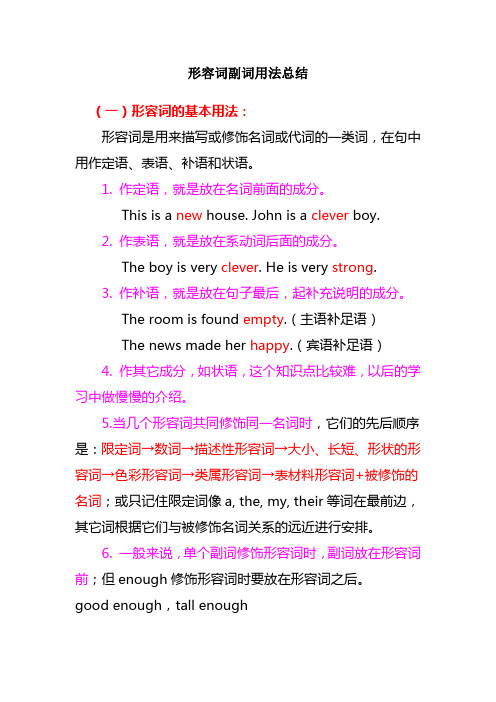
形容词副词用法总结(一)形容词的基本用法:形容词是用来描写或修饰名词或代词的一类词,在句中用作定语、表语、补语和状语。
1. 作定语,就是放在名词前面的成分。
This is a new house. John is a clever boy.2. 作表语,就是放在系动词后面的成分。
The boy is very clever. He is very strong.3. 作补语,就是放在句子最后,起补充说明的成分。
The room is found empty.(主语补足语)The news made her happy.(宾语补足语)4. 作其它成分,如状语,这个知识点比较难,以后的学习中做慢慢的介绍。
5.当几个形容词共同修饰同一名词时,它们的先后顺序是:限定词→数词→描述性形容词→大小、长短、形状的形容词→色彩形容词→类属形容词→表材料形容词+被修饰的名词;或只记住限定词像a, the, my, their等词在最前边,其它词根据它们与被修饰名词关系的远近进行安排。
6. 一般来说,单个副词修饰形容词时,副词放在形容词前;但enough修饰形容词时要放在形容词之后。
good enough,tall enough7. 形容词修饰名词时放在前边,但修饰复合不定代词(something,someone,somebody;anything,anyone,anybody;nothing,no one,nobody)时,则放在这些词之后something important,anything possible。
(二)副词的基本用法:副词是用以修饰动词、形容词、副词以及全句的词,表示时间、地点、方式、程度、疑问等概念。
1. 作状语:The students watch him quietly. (修饰动词)2. 作表语:Time is up. Let’s go. (表示状态)3. 作定语:Life there is very dull. (一般后置)4. 修饰形容词或副词,表示程度:His invention is very useful. (修饰形容词)Henry sings quite well. (修饰副词)5. 副词作状语时,位置很灵活:He walks slowly. (动词后)I often swim in summer.(动词前)Maybe you are right. (句首)That’s all right. (形容词前)Tom speaks too quickly.(副词前)6. 副词表示频度,修饰动词时位于系动词be和助动词后,行为动词do之前,还可置于句首或句末。
初中的归纳常见的副词与介词短语的用法总结

初中的归纳常见的副词与介词短语的用法总结副词和介词短语是英语中常见的词类,在表达中起着重要的作用。
它们可以修饰动词、形容词、副词以及整个句子,增强语言表达的准确性和灵活性。
下面将对初中阶段常见的副词与介词短语的使用进行总结与归纳。
一、副词的用法1. 时间状语副词在句子中用来表示动作或状态发生的时间,如often(经常地)、always(总是)、usually(通常)、sometimes(有时候)、rarely(很少)、never(从不)等。
例如:- I often go to the park on weekends.(我经常在周末去公园。
)- He never stays up late.(他从不熬夜。
)2. 地点状语副词在句子中用来表示动作发生的地点,如here(这里)、there(那里)、everywhere(到处)、somewhere(某处)等。
例如: - The cat is sleeping over there.(那只猫在那里睡觉。
)- Let's go somewhere fun this weekend.(这周末我们去个有趣的地方吧。
)3. 方式状语副词在句子中用来表示动作进行的方式,如fast(快速地)、slowly (慢慢地)、carefully(小心地)、loudly(大声地)等。
例如: - She sings beautifully.(她唱得很美。
)- The baby is sleeping soundly.(宝宝睡得很香。
)4. 程度副词表示动作、形容词和副词的程度,如very(非常)、too(太)、so(如此)、quite(相当)等。
例如:- The movie was very exciting.(这部电影非常刺激。
)- He speaks English fluently.(他讲英语非常流利。
)二、介词短语的用法1. 时间介词短语表示动作发生的时间,如in the morning(在早上)、on Monday (在星期一)、at night(在晚上)等。
关于初中英语语法关于对副词用法的大全
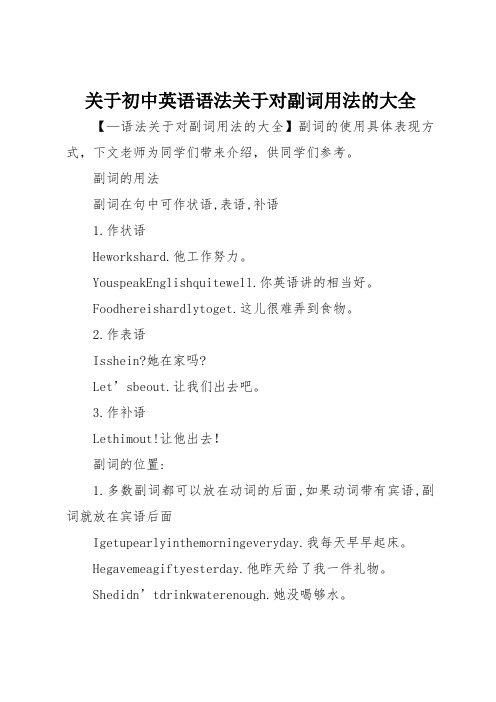
关于初中英语语法关于对副词用法的大全【—语法关于对副词用法的大全】副词的使用具体表现方式,下文老师为同学们带来介绍,供同学们参考。
副词的用法副词在句中可作状语,表语,补语1.作状语Heworkshard.他工作努力。
YouspeakEnglishquitewell.你英语讲的相当好。
Foodhereishardlytoget.这儿很难弄到食物。
2.作表语Isshein?她在家吗?Let’sbeout.让我们出去吧。
3.作补语Lethimout!让他出去!副词的位置:1.多数副词都可以放在动词的后面,如果动词带有宾语,副词就放在宾语后面Igetupearlyinthemorningeveryday.我每天早早起床。
Hegavemeagiftyesterday.他昨天给了我一件礼物。
Shedidn’tdrinkwaterenough.她没喝够水。
Thetraingoesfast.火车跑得快。
Wecangotothisschoolfreely.我们可以免费到这家学校学习。
Theyleftalifehardlythen.当时他们的生活很艰难。
Hehasanewcatontoday.他今天戴了一顶新帽子。
Ihaveseenthisfilmtwicewithmyfriends.这部电影我和朋友看过两次。
2.副词修饰形容词,副词时,副词在前面,而被修饰的词在后面It’srathereasy,Icandoit.这很容易,我能做到。
Hediditquitewell.他做得相当好。
It’sratherdifficulttotellwhoisright.很难说谁是对的。
It’ssoimportantthatImusttellmyfriends.这件事太重要了,我得告诉我的朋友。
It’smuchbetter.好多了。
3.频度副词可放在实义动词的前面,情态动词和助动词的后面Ioftenhelphimthesedays.这些日子我经常帮助他。
英语中副词及用法规律总结
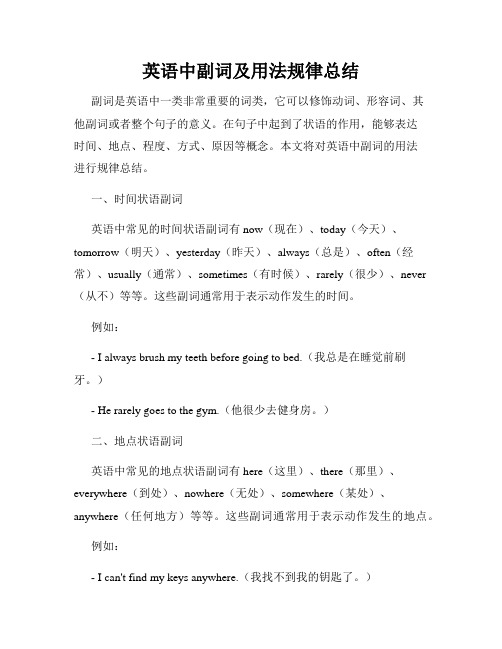
英语中副词及用法规律总结副词是英语中一类非常重要的词类,它可以修饰动词、形容词、其他副词或者整个句子的意义。
在句子中起到了状语的作用,能够表达时间、地点、程度、方式、原因等概念。
本文将对英语中副词的用法进行规律总结。
一、时间状语副词英语中常见的时间状语副词有now(现在)、today(今天)、tomorrow(明天)、yesterday(昨天)、always(总是)、often(经常)、usually(通常)、sometimes(有时候)、rarely(很少)、never (从不)等等。
这些副词通常用于表示动作发生的时间。
例如:- I always brush my teeth before going to bed.(我总是在睡觉前刷牙。
)- He rarely goes to the gym.(他很少去健身房。
)二、地点状语副词英语中常见的地点状语副词有here(这里)、there(那里)、everywhere(到处)、nowhere(无处)、somewhere(某处)、anywhere(任何地方)等等。
这些副词通常用于表示动作发生的地点。
例如:- I can't find my keys anywhere.(我找不到我的钥匙了。
)- There are beautiful flowers everywhere in the garden.(花园里到处都是美丽的花。
)三、方式状语副词英语中常见的方式状语副词有slowly(慢慢地)、quickly(快速地)、carefully(仔细地)、easily(容易地)、quietly(安静地)等等。
这些副词通常用于表示动作进行的方式。
例如:- She speaks English fluently.(她英语说得很流利。
)- The children played happily in the park.(孩子们在公园里开心地玩耍。
)四、程度状语副词英语中常见的程度状语副词有very(非常)、quite(相当)、too (太)、so(如此)、almost(几乎)、only(仅仅)、rather(相当)等等。
英语中的状语定义是什么有哪些用法
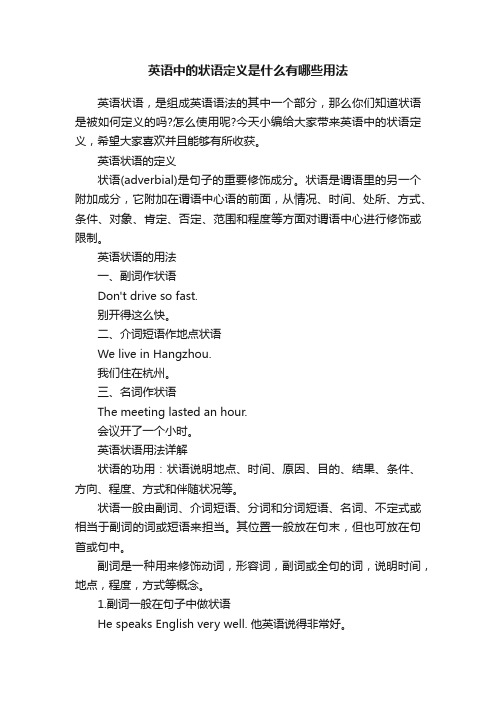
英语中的状语定义是什么有哪些用法英语状语,是组成英语语法的其中一个部分,那么你们知道状语是被如何定义的吗?怎么使用呢?今天小编给大家带来英语中的状语定义,希望大家喜欢并且能够有所收获。
英语状语的定义状语(adverbial)是句子的重要修饰成分。
状语是谓语里的另一个附加成分,它附加在谓语中心语的前面,从情况、时间、处所、方式、条件、对象、肯定、否定、范围和程度等方面对谓语中心进行修饰或限制。
英语状语的用法一、副词作状语Don't drive so fast.别开得这么快。
二、介词短语作地点状语We live in Hangzhou.我们住在杭州。
三、名词作状语The meeting lasted an hour.会议开了一个小时。
英语状语用法详解状语的功用:状语说明地点、时间、原因、目的、结果、条件、方向、程度、方式和伴随状况等。
状语一般由副词、介词短语、分词和分词短语、名词、不定式或相当于副词的词或短语来担当。
其位置一般放在句末,但也可放在句首或句中。
副词是一种用来修饰动词,形容词,副词或全句的词,说明时间,地点,程度,方式等概念。
1.副词一般在句子中做状语He speaks English very well. 他英语说得非常好。
其中的“very”是程度副词,用来修饰“well”。
“very well”是修饰“speak”的程度状语。
2. 不定式在句子中可以作目的状语I come specially to see you. 我专门来看你。
3.介词短语Ten years ago, She began to live in Dalian.从十年以前开始,她开始住在了大连。
The boy was praised for his bravery.这个男孩因为他的勇敢而被夸奖。
4.从句作状语When she was 12 years old, she began to live in Dalian.她12岁的那一年开始居住于大连。
英语语法状语的用法

大家也知道英语语法中,状语也是占有重要一席地位.状语是句子的重要修饰成分。
可是具体怎么用,还必须理解壮语在英语语法中到底扮演一个什么样的角色。
状语是谓语里的另一个附加成分,它附加在谓语中心语的后面,从情况、时间、处所、方式、条件、对象、肯定、否定、范围和程度等方面对谓语中心进行修饰或限制。
那么就随着南通英语培训班的学员看看哪些词可以做状语:一、副词作状语二、介词短语作地点状语三、名词作状语1.Don't drive so fast.2.We live in Hangzhou.3.The meeting lasted an hour.给大家提供一些关于状语的练习题如下:1. It was quiet ________ those big trucks started coming through the town.A. before B. after C. until D. unless2. It seemed only seconds ________ the boy finished washing his face.A. when B. before C. afterD. even if3. Hardly had he reached the school gate ________ the bell rang.A. while B. when C. as D. as soon as4.We were told that we should follow the main road _____ we reached the central railway station.A. whenever B. until C. while D. wherever5. I recognized you ________ I saw you at the airport.A. the moment B. while C. after D. once6. He was about to go to bed ________ the doorbell rang.A. while B. as C. before D. when7.________I listen to your advice, I get into trouble.A. Every time B. When C. While D. Until8. _____ John was watching TV, his wife was cooking.A. As B. As soon as C. While D. Till9. The children ran away from the orchard(果园) ______they saw the guard.A. the moment B. after C. before D. as10. No sooner had I arrived home _____ it began to rain.A. when B. while C. as D. than。
英语语法之副词

英语语法之副词英语语法之副词下面是对英语中副词的用法知识讲解学习,同学们我们一起来分享下面的知识吧。
副词的用法(1)副词在句中可作状语,表语和定语。
Hestudiesveryhard.(作状语)Lifehereisfullofjoy.(作定语)Whenwillyoubeback?(作表语)副词按其用途和含义可分为下面五类:1)时间副词时间副词通常用来表示动作的时间。
常见的时间副词有:nowtoday,tomorrow,yesterday,before,late,early,never,seldom, sometimes,often,usually,always等。
例如:Heoftencomestoschoollate.Whatarewegoingtodotomorrow?HeisneverbeentoBeijing.2)地点副词地点副词通常用来表示动作发生的地点。
常见的地点副词有:here,there,inside,outside,home,upstairs,downstairs,anywhere ,everywhere,nowhere,somewhere,down,up,off,on,in,out等。
例如:Imetanoldfriendofmineonmywayhome.Hewentupstairs.Putdownyournamehere.3)方式副词方式副词一般都是回答“怎样的?”这类问题的,其中绝大部分都是由一个形容词加词尾-ly构成的,有少数方式副词不带词尾-ly,它们与形容词同形。
常见的方式副词有:anxiously,badly,bravely,calmly,carefully,proudly,rapidly,su ddenly,successfully,angrily,happily,slowly,warmly,well,fast,slow,quick,hard,alone,high,straight,wide等。
英语中副词的基本用法有哪些
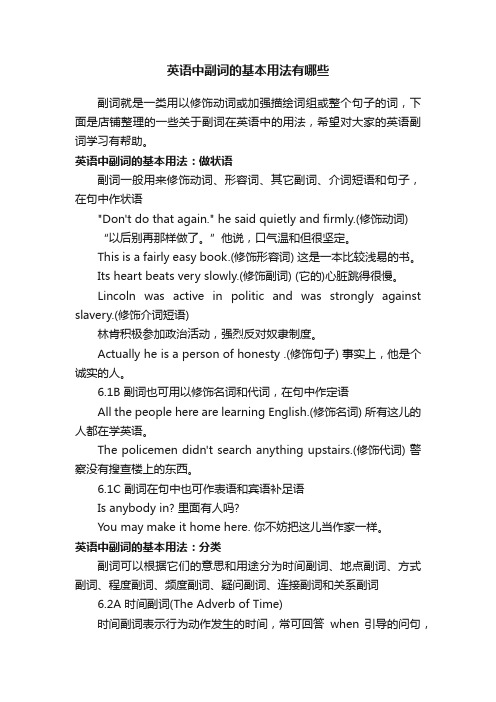
英语中副词的基本用法有哪些副词就是一类用以修饰动词或加强描绘词组或整个句子的词,下面是店铺整理的一些关于副词在英语中的用法,希望对大家的英语副词学习有帮助。
英语中副词的基本用法:做状语副词一般用来修饰动词、形容词、其它副词、介词短语和句子,在句中作状语"Don't do that again." he said quietly and firmly.(修饰动词)“以后别再那样做了。
”他说,口气温和但很坚定。
This is a fairly easy book.(修饰形容词) 这是一本比较浅易的书。
Its heart beats very slowly.(修饰副词) (它的)心脏跳得很慢。
Lincoln was active in politic and was strongly against slavery.(修饰介词短语)林肯积极参加政治活动,强烈反对奴隶制度。
Actually he is a person of honesty .(修饰句子) 事实上,他是个诚实的人。
6.1B 副词也可用以修饰名词和代词,在句中作定语All the people here are learning English.(修饰名词) 所有这儿的人都在学英语。
The policemen didn't search anything upstairs.(修饰代词) 警察没有搜查楼上的东西。
6.1C 副词在句中也可作表语和宾语补足语Is anybody in? 里面有人吗?You may make it home here. 你不妨把这儿当作家一样。
英语中副词的基本用法:分类副词可以根据它们的意思和用途分为时间副词、地点副词、方式副词、程度副词、频度副词、疑问副词、连接副词和关系副词6.2A 时间副词(The Adverb of Time)时间副词表示行为动作发生的时间,常可回答when 引导的问句,时间副词有表示确切时间和模糊时间两种。
初中英语副词知识点:副词作状语时在句子中的位置

初中英语副词知识点:副词作状语时在句子中的位置初中英语副词知识点:副词作状语时在句子中的位置作状语:①时间副词:一般放在句首或句尾,注意,early、late、before、later、yet等一般放在句尾,already、just一般放在动词的前面。
如:We will visit the Great Wall tomorrow.(我们明天要去参观长城) / They have already been to the UK twice.(他们去过英王国两次) / Soon the lost boy found his way back home.(不久迷路的孩子找到了回家的路)②频度副词:一般放在be动词之后或者助动词与主要动词之间,但sometimes、often 等还可以放在句首或句尾,usually可放在句首,once可放在句尾,twice、three times等一般放在句尾。
如:Sometimes I get up early.(我有时起得早)/ The workers usually have lunch at the factory.(工人们通常在厂里吃午饭) / Take this medicine twice a day.(这种药一天吃两次)③方式副词:一般放在行为动之后,suddenly可以放在句首、句尾或动词之前。
如:Old people can hardly walk as quickly as young people.(老年人几乎不可能走得和年轻人一样快) / Suddenly he saw a light in the dark cave(山洞).(突然,在黑黢黢的山洞里,他看见了一丝亮光)④地点副词:一般放在句尾,但here、there还可放在句首。
如:There you can see thousands of bikes running in all directions(方向).(在那里,你可以看到成千上万的自行车朝各个方向流动) / The frightened wolf ran away.(受到惊吓的狼逃开了)/ He walked out quietly and turned back soon.(他悄悄地走了出去,很快又返回)⑤程度副词:修饰动词时,放在动词之前;修饰形容词或副词时,放在形容词或副词之前。
英语副词的分类及用法
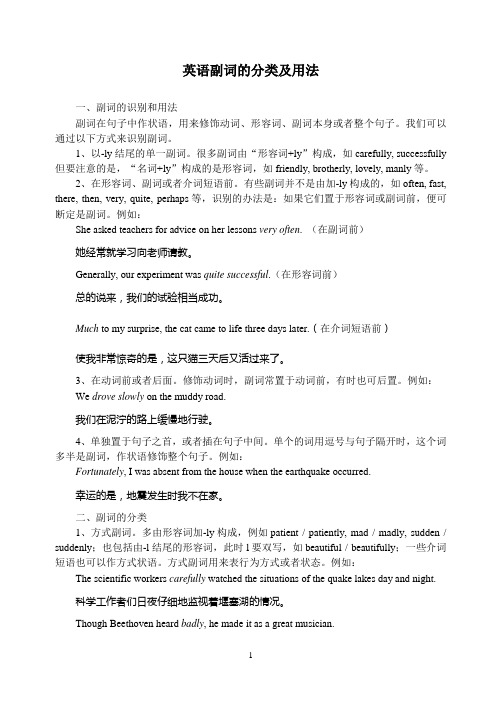
英语副词的分类及用法一、副词的识别和用法副词在句子中作状语,用来修饰动词、形容词、副词本身或者整个句子。
我们可以通过以下方式来识别副词。
1、以-ly结尾的单一副词。
很多副词由“形容词+ly”构成,如carefully, successfully 但要注意的是,“名词+ly”构成的是形容词,如friendly, brotherly, lovely, manly等。
2、在形容词、副词或者介词短语前。
有些副词并不是由加-ly构成的,如often, fast, there, then, very, quite, perhaps等,识别的办法是:如果它们置于形容词或副词前,便可断定是副词。
例如:She asked teachers for advice on her lessons very often. (在副词前)她经常就学习向老师请教。
Generally, our experiment was quite successful.(在形容词前)总的说来,我们的试验相当成功。
Much to my surprise, the cat came to life three days later.(在介词短语前)使我非常惊奇的是,这只猫三天后又活过来了。
3、在动词前或者后面。
修饰动词时,副词常置于动词前,有时也可后置。
例如:We drove slowly on the muddy road.我们在泥泞的路上缓慢地行驶。
4、单独置于句子之首,或者插在句子中间。
单个的词用逗号与句子隔开时,这个词多半是副词,作状语修饰整个句子。
例如:Fortunately, I was absent from the house when the earthquake occurred.幸运的是,地震发生时我不在家。
二、副词的分类1、方式副词。
多由形容词加-ly构成,例如patient / patiently, mad / madly, sudden / suddenly;也包括由-l结尾的形容词,此时l要双写,如beautiful / beautifully;一些介词短语也可以作方式状语。
中考英语专题复习:副词分类和用法

近几年中考对于副词的考查侧重频度副词、 程度副词、以及以-ly结尾的副词,形容词和副 词的混合辨析也是考试重点。所以要求考生重 点掌握常见副词的构成、分类和辨析。
解答副词在语境中辨析类试题,首先要确 定各选项的含义,然后分析语境和逻辑关系, 最后确定正确答案。
children playing with matches. ___A____, no one was hurt.
A. Luckily B. Suddenly C. Easily D. Sadly
2. It was late. She opened the door ____B____ because she didn't want
副词的用法
3. She got to the station early enough to catch the first bus. 她早早地赶到车站赶上了首班车。
4. Surprisingly, he was offered a good job. 令人惊讶的是,他竟然得到了一份好工作。
副词的用法
副词的用法
一、作状语,修饰动词、形容词、副词、句子等。 1. We will visit the Great Wall tomorrow.
我们明天要去参观长城。 2. It’s so strange that I could hardly believe my ears.
太奇怪了,我都不能相信我的耳朵。
to wake up her grandma.
A. angrily B. quietly
C. loudly D. heavily
3. ---Please drive ___C___ when you pass a school. ---OK.
初中英语副词知识点:副词的基本用法

初中英语副词知识点:副词的基本用法各位读友大家好,此文档由网络收集而来,欢迎您下载,谢谢初中英语副词知识点:副词的基本用法副词在句中主要用作状语,修饰动词、形容词、副词、介词短语或句子。
⑴修饰动词,表示时间、地点、程度、方式、频度等。
一般位于动词之后,如果动词有宾语,则要位于宾语之后。
频度副词常位于助动词和连系动词be 之后或实义动词之前。
例如:He arrived only yesterday. 他是昨天才到的。
There were clothes lying here and there on the floor. 地板上到处都是衣服。
I have been terribly worried about you all day. 我一整天都非常为你担心。
She plays the piano very well. 她钢琴弹得很好。
The boy is always asking his parents for money. 那个男孩老是向他父母要钱。
She never goes to the cinema. 她向来不看电影。
⑵修饰形容词、副词、介词短语,一般前置,只有enough例外,需要后置。
例如:She seems quite happy. 她看上去相当愉快。
You’ve done rather badly in the test. 你考得够糟糕的。
The wind was right in our faces. 风迎面吹来。
This girl is not old enough to go to school. 这个女孩还没有到上学的年龄。
He didn’t run fast enough to catch the train. 他跑得不够快,没有赶上火车。
⑶用作表语,多为与介词同形的副词和表示方位的副词。
例如:Is anybody in? 里面有人吗?有人在家吗?Father is away. 父亲离家在外。
初中副词不定式用法讲解

初中副词不定式用法讲解副词不定式是一种形容词、副词和动词的混合形式,可以在句子中作状语,修饰动词、形容词或副词。
用法副词不定式的主要用法有以下几种:1. 修饰动词:常用于表示目的、结果或方式。
- 目的:She left early to catch the train.- 结果:He spoke loudly enough to be heard.- 方式:He walked quickly to avoid the rain.2. 修饰形容词或副词:常用于表示程度或程度的变化。
- 程度变化:The coffee was hot enough to burn his tongue.3. 表示让步:常用于表示虽然某种情况存在,但仍然发生了某件事情。
- 让步:Although he was tired, he kept working.注意事项1. 副词不定式通常放在动词、形容词或副词后面,但也可以放在句子开头或结尾。
- 放在动词后:He came here to study.- 放在形容词后:She was too busy to help.- 放在副词后:He sings well enough to be a professional.- 放在句子开头:To be honest, I don't like him.- 放在句子结尾:I want to quit, but it's not easy to do so.2. 不定式前面的动词一般要用原形,但有时也会用现在分词或过去分词。
- 原形:I decided to go hiking this weekend.- 现在分词:They were excited to be going on vacation.- 过去分词:She was surprised to see him at the party.3. 副词不定式与名词或代词连用时,一般要用介词“for”。
【英语知识点】very much的详细用法

【英语知识点】very much的详细用法very much是副词,副词一般用来作状语修饰动词,一般用它来修饰动词,表示动作的程度,(外国人很善于表达感情的)比如:Thank you very much 修饰感谢;I love you very much 修饰love。
very,much与very much的用法一、副词very主要修饰形容词或副词He was very angry at losing it.丢失了它他很生气。
He believes very strongly in female emancipation.他强烈主张妇女解放。
二、副词much主要修饰动词,而且除非其前有very,too,so等修饰语,它只用于否定句和疑问句。
She doesn’t like him much.她不太喜欢他。
Does she much like him?/Does she like him much?她很喜欢他吗?注:不带修饰语的much有时也可能在肯定句中修饰动词,但这只限于regret,admire,prefer,appreciate等少数动词,且此时的much应置于句中,而不是句末。
三、much除修饰动词外,还可修饰比较级和最高级以及介词短语等。
This is much the most difficult.这是最最困难的。
四、修饰过去分词,通常用much,不用very。
但修饰已经转化成形容词的过去分词,或形容词性较强的过去分词(如过去分词作定语时),则可用very。
五、very much 是 much的强调说法,从理论上说,可用much的地方,原则上也可用very much。
感谢您的阅读,祝您生活愉快。
初中英语语法对副词用法的
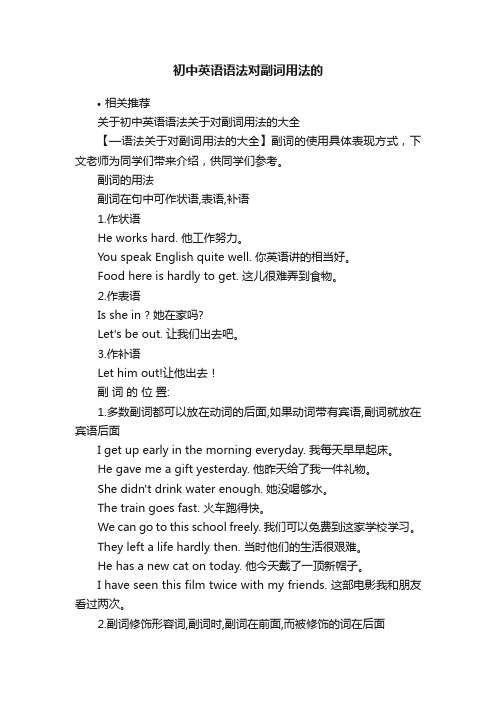
初中英语语法对副词用法的•相关推荐关于初中英语语法关于对副词用法的大全【—语法关于对副词用法的大全】副词的使用具体表现方式,下文老师为同学们带来介绍,供同学们参考。
副词的用法副词在句中可作状语,表语,补语1.作状语He works hard. 他工作努力。
You speak English quite well. 你英语讲的相当好。
Food here is hardly to get. 这儿很难弄到食物。
2.作表语Is she in ? 她在家吗?Let's be out. 让我们出去吧。
3.作补语Let him out!让他出去!副词的位置:1.多数副词都可以放在动词的后面,如果动词带有宾语,副词就放在宾语后面I get up early in the morning everyday. 我每天早早起床。
He gave me a gift yesterday. 他昨天给了我一件礼物。
She didn't drink water enough. 她没喝够水。
The train goes fast. 火车跑得快。
We can go to this school freely. 我们可以免费到这家学校学习。
They left a life hardly then. 当时他们的生活很艰难。
He has a new cat on today. 他今天戴了一顶新帽子。
I have seen this film twice with my friends. 这部电影我和朋友看过两次。
2.副词修饰形容词,副词时,副词在前面,而被修饰的词在后面It's rather easy, I can do it. 这很容易,我能做到。
He did it quite well. 他做得相当好。
It's rather difficult to tell who is right. 很难说谁是对的。
- 1、下载文档前请自行甄别文档内容的完整性,平台不提供额外的编辑、内容补充、找答案等附加服务。
- 2、"仅部分预览"的文档,不可在线预览部分如存在完整性等问题,可反馈申请退款(可完整预览的文档不适用该条件!)。
- 3、如文档侵犯您的权益,请联系客服反馈,我们会尽快为您处理(人工客服工作时间:9:00-18:30)。
① 时间副词:一般放在句首或句尾,注意,early、late、before、later、yet等一般放在句尾,already、just一般放在动词的前面。如:We will visit the Great Wall tomorrow.(我们明天要去参观长城) / They have already been to the UK twice.(他们去过英王国两次) / Soon the lost boy found his way back home.(不久迷路的孩子找到了回句尾;also放在动词前;either “也不”,放在句尾;nor“也不”,放在句首;so“如此,这样”,放在形容词、副词前;on/off“开/关”放在动词之后;not放在be之后、助动词之后、不定式或动名词之前;maybe/perhaps放在句首;certainly放在句首或动词之前。如:He went to the Palace Museum and I went there,too.(他去了故宫博物院,我也去了) / Maybe your ticket is in your inside pocket.(也许你的票就在你的里边衣袋里) / --Tom doesn’t have a computer. –Nor do I.(汤姆没有计算机,我也没有。)
⑤ 程度副词:修饰动词时,放在动词之前;修饰形容词或副词时,放在形容词或副词之前。但注意,enough总是放在被修饰的形容词或动词的后面;only位置比较灵活,总是放在被修饰的词的前面。如:I nearly forgot all about it if he did not tell me again.(如果他不再次告诉我,我几乎把那事全忘了) / It was so strange that I could hardly believe my ears.(它那么奇怪一直我都不能相信我的耳朵) / She got to the station early enough to catch the first bus.(她早早地赶到车站赶上了首班车)
④ 地点副词:一般放在句尾,但here、there还可放在句首。如:There you can see thousands of bikes running in all directions(方向).(在那里,你可以看到成千上万的自行车朝各个方向流动) / The frightened wolf ran away.(受到惊吓的狼逃开了)/ He walked out quietly and turned back soon.(他悄悄地走了出去,很快又返回)
⑥ 疑问副词:用于对句子的状语进行提问,位置总是在句首。如:When and where were you born?(你何时何地出生?)/ Why did little Edison sit on some eggs?(小爱迪生为什么要坐在鸡蛋上?)/ How do you do?(你好!)
⑦ 连接副词:用来引导主语从句、宾语从句和表语从句,在从句中作状语。How I am going to kill the cat is still a question.(我打算怎样杀死那只猫还是个问题)/ That is why everyone is afraid of the tiger.(那就是人人都害怕老虎的原因) / He wondered how he could do it the next day.(他不知道第二天怎样做那事)
② 频度副词:一般放在be动词之后或者助动词与主要动词之间,但sometimes、often等还可以放在句首或句尾,usually可放在句首,once可放在句尾,twice、three times等一般放在句尾。如:Sometimes I get up early.(我有时起得早)/ The workers usually have lunch at the factory.(工人们通常在厂里吃午饭) / Take this medicine twice a day.(这种药一天吃两次)
③ 方式副词:一般放在行为动之后,suddenly可以放在句首、句尾或动词之前。如:Old people can hardly walk as quickly as young people.(老年人几乎不可能走得和年轻人一样快) / Suddenly he saw a light in the dark cave(山洞).(突然,在黑黢黢的山洞里,他看见了一丝亮光)
⑧ 关系副词:用来引导定语从句,在从句中作状语。如:This is the place where Mr Zhang once lived.(这就是张先生曾经住过的地方)/ Please tell me the way how you have learned English so well.(请告诉我你的英语是怎样学得这么好的方法)
